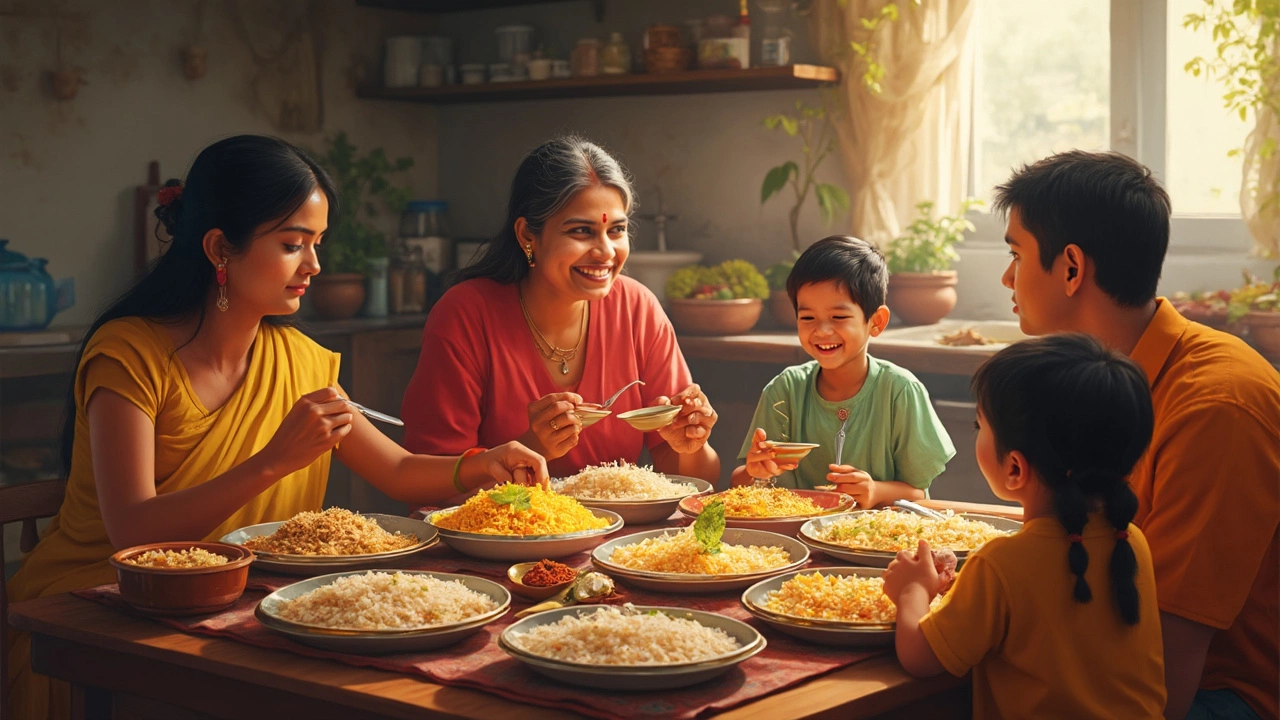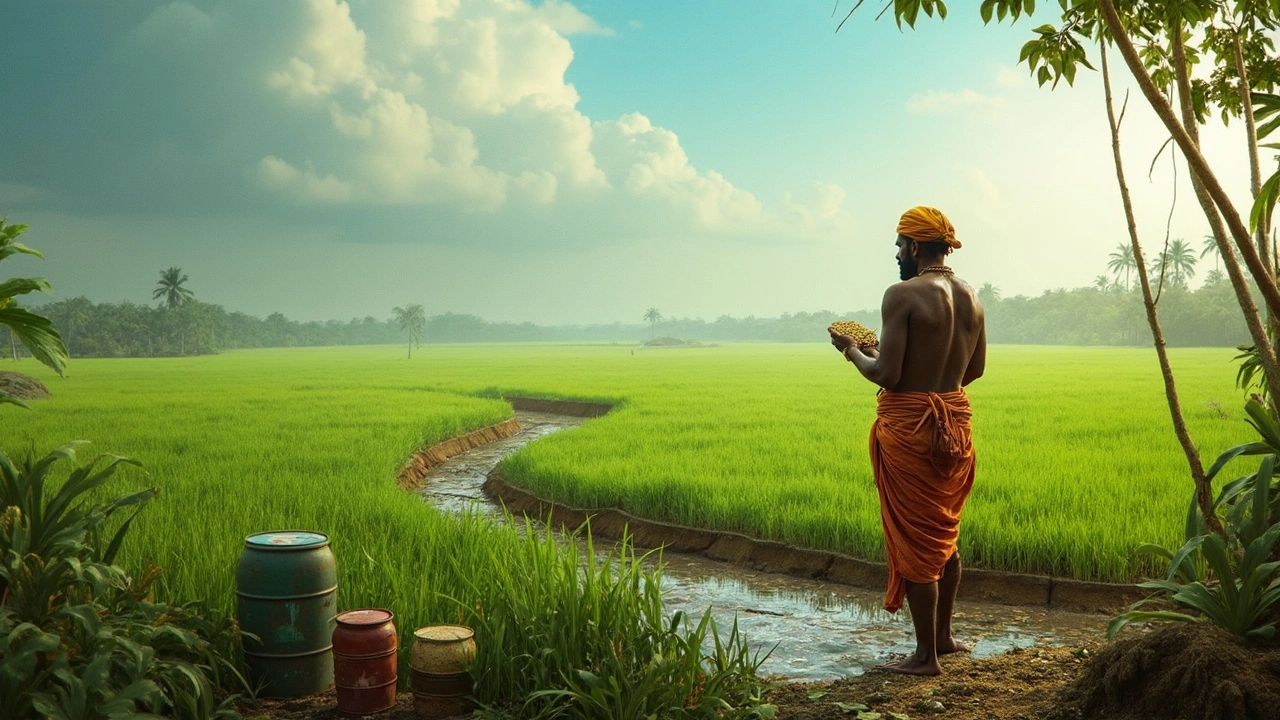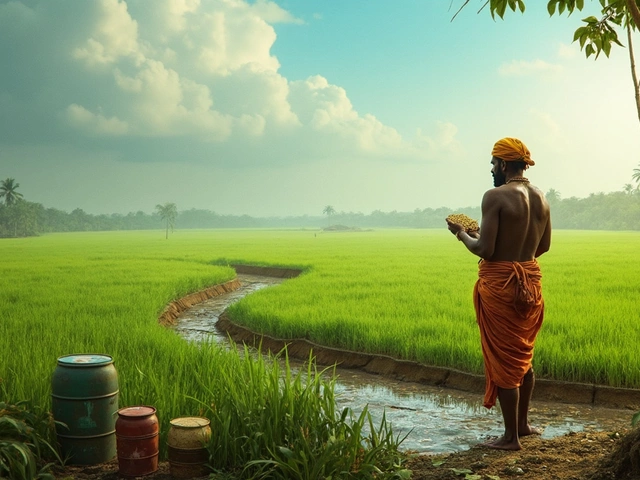Most people think of rice as harmless, maybe even boring. But once you peel back the surface, rice has a long list of issues hiding behind those little grains. For starters, it’s one of the thirstiest crops you can grow. Rice farms use more water than almost any other food crop, which puts serious pressure on local water supplies—especially in places where drought is becoming more common.
If you’re a rice farmer or thinking about growing your own, water management is something you can’t ignore. A single kilo of rice can take over 2,000 liters of water. That’s a crazy amount when you realize just how much rice the world eats every day. No wonder some regions are struggling to keep their rivers and underground water sources from drying up.
- Water Woes: Rice Needs Thirsty Fields
- Chemicals in the Crop
- Rice and Climate Change
- Nutritional Shortfalls
- Arsenic: The Quiet Contaminant
- Tips for Safer Growing and Eating
Water Woes: Rice Needs Thirsty Fields
Here’s the deal: rice farming is a water guzzler. It’s not just a bit thirsty—rice cultivation means fields need to stay flooded for weeks. That steady water is what helps the plants grow strong and keeps weeds and pests away. But it costs a ton of water. Some experts say that up to 40% of the world’s water used for irrigation in farming goes into rice fields.
Take a look at how much water we’re talking about for different crops:
| Crop | Water Needed per Kilo (Liters) |
|---|---|
| Rice | ~2,500 |
| Wheat | ~1,800 |
| Corn | ~900 |
That’s not an exaggeration. Growing one kilo of rice can take about three times more water than corn. As temperatures climb and rainfall gets less reliable, this becomes a real headache for farmers—and for anyone who depends on that water for drinking or other crops.
If you’re thinking about getting into rice farming, you need a plan for water management. Some farmers have started using methods like Alternate Wetting and Drying (AWD). Instead of keeping fields constantly flooded, they let the water drain out before flooding again. This can drop water use by up to 30%. Plus, it’s better for the environment because it cuts down on greenhouse gases from flooded fields.
- Check if your area has reliable water sources before planting rice.
- Look into water-saving techniques like AWD or drip irrigation.
- Keep an eye on local drought warnings and get ready to adjust your approach if needed.
Bottom line: growing rice is tough on water supplies. If you want to get into rice cultivation, don’t skip the homework on how to handle all that water.
Chemicals in the Crop
Growing rice on a large scale almost always means using chemicals—think fertilizers, pesticides, and herbicides. These chemicals are supposed to boost yields and keep pests away, but they have some pretty obvious downsides. For one, the heavy use of nitrogen fertilizers in rice cultivation leads to chemical runoff into rivers and lakes. This runoff can cause fish kills and increases algae that choke waterways.
Pesticides are another headache. In many rice-growing regions, fields are sprayed multiple times each season. Over time, pests develop resistance, so farmers have to use even more or switch to stronger options. Not only does this drive up costs, but it can also lead to chemical residues on the rice itself. If you’re eating a lot of conventionally grown rice, especially from countries with looser regulations, you could be taking in trace amounts of these residues.
- India and China, the top rice producers, use millions of tons of fertilizers every year on their fields.
- Some common herbicides found in rice paddies—like butachlor and pretilachlor—can stick around in soil and water for months.
- Repeated spraying hasn’t just affected pests; it can also harm frogs, fish, and even beneficial insects that keep the local environment balanced.
Now, before you get totally put off, there are ways to limit this problem. If you’re growing your own rice, check out integrated pest management (IPM). This approach means you use chemicals only when you really have to, and you try other tricks—like rotating crops or releasing pest-eating insects—to keep things in check. Even if you’re buying rice, look for sources that mention lower chemical use, like certified organic brands, or producers who practice sustainable rice farming.
For folks worried about residues, rinsing and soaking rice before cooking can lower pesticide levels a bit. But remember, it won’t remove everything—especially if pollutants soaked into the grain as it was growing.
| Chemical | Typical Use in Rice Farming | Potential Impact |
|---|---|---|
| Nitrogen Fertilizer | Boosts plant growth | Water pollution, algae blooms |
| Butachlor | Weed control | Long soil and water persistence |
| Organophosphate Pesticides | Pest control | Toxic for aquatic life, residue on grain |
Rice and Climate Change
When you think about rice cultivation, climate change is not the first thing that pops into your head. But rice farming actually plays a surprising role in global warming. The big issue is methane. Flooded rice fields create the perfect conditions for bacteria that release methane—a greenhouse gas a lot more powerful than carbon dioxide.
According to the International Rice Research Institute, rice paddies are responsible for up to 12% of total global methane emissions from agriculture. That's a chunk of the problem, especially since rice is such a popular food. To put it into perspective, if rice farming were a country, it would be among the top greenhouse gas emitters every year.
“The world’s rice fields emit almost 500 million tons of methane into the atmosphere every year, making them a key player in agricultural greenhouse gas emissions.” — Food and Agriculture Organization (FAO)
As climate change makes weather more unpredictable, rice farming gets even trickier. More frequent floods and droughts mess with harvests and can reduce yields. Farmers often respond by using more chemical fertilizers, thinking it’ll save their crops, but that loops right back to more emissions and even more climate headaches.
Here’s a quick look at how rice farming interacts with the environment:
| Factor | Climate Impact |
|---|---|
| Flooded Fields | Raise methane emissions |
| Fertilizer Use | Boosts nitrous oxide, another greenhouse gas |
| Changing Rainfall | Hurts harvest and water supply |
Some farmers are testing smart ways to cut emissions, like switching between wet and dry growing cycles, or planting rice strains that need less water. These methods can really help, but they’re not easy for everyone to try, especially for small farms with tight budgets. If you grow rice, or want to reduce your climate footprint, looking into sustainable methods is a solid move. Your field, your rules—just try making those rules climate-friendly.

Nutritional Shortfalls
Here’s something a lot of folks don’t realize: while rice fills you up, it doesn’t always give your body the nutrients it craves. Most of the rice people eat, especially white rice, is missing a lot of vitamins, minerals, and fiber. During processing, the outer layers packed with good stuff get stripped away. What’s left is mostly just simple carbs.
If rice cultivation is your thing, you probably grow what sells, right? Usually, that means white rice because it looks clean and cooks fast. But white rice has almost no fiber and a lot less B vitamins, iron, and magnesium compared to whole-grain options like brown rice. That’s why nutritionists suggest mixing up the kind of rice you eat—or even better, growing rice varieties that leave some of that nutrition in.
Let’s break it down:
| Type of Rice | Fiber (g per 100g cooked) | Magnesium (mg) | Iron (mg) |
|---|---|---|---|
| White Rice | 0.4 | 12 | 0.2 |
| Brown Rice | 1.8 | 43 | 0.4 |
Eating mostly white rice can raise your blood sugar, which isn’t great if you’re trying to watch your health, especially with diabetes or prediabetes in the family. It’s got a high glycemic index, meaning it can spike your blood sugar pretty quickly. Even if you’re young and fit, it doesn't hurt to mix in brown rice or other grains.
- If you’re growing rice, look into varieties higher in nutrients or with added vitamins. Some farmers branch into red, purple, or black rice, which naturally have more antioxidants.
- If you eat a lot of rice, don’t just stick to one type. Swap in brown or wild rice when you can for extra nutrition.
Rice can be part of a healthy diet, but it’s not a nutrition powerhouse on its own. For all the effort that goes into rice farming, it makes sense to make the crop as wholesome as possible—for you and everyone at your table.
Arsenic: The Quiet Contaminant
Most people don’t realize it, but rice has a knack for picking up arsenic from the soil and water where it grows. It’s not like farmers add it on purpose—arsenic is a natural element found in the earth, but it can also get into fields from pesticides and fertilizers that were used years ago. This is a big deal because rice plants absorb more arsenic than most other food crops, and it sticks around right up to your dinner plate.
Here’s what might shock you: a 2023 Food and Agriculture Organization survey showed that rice can have arsenic levels up to 10 times higher than wheat or corn grown in the same area. Brown rice tends to soak up more arsenic than white rice, since the outer layers (which are kept in brown rice) hold on to more contaminants.
Long-term exposure to arsenic—even at low levels—has been linked to health risks like heart disease, diabetes, and even some cancers. This is especially tough on kids since they eat more food per body weight. The World Health Organization says there’s no completely safe level of arsenic in food, but it does set a maximum for what’s allowed in rice to help keep things under control.
| Rice Type | Average Arsenic Content (µg/kg) |
|---|---|
| Basmati | 56 |
| Brown Rice | 150 |
| White Rice | 90 |
The good news? You can lower arsenic exposure by rinsing rice thoroughly before cooking and by boiling it in excess water (like you do with pasta) then draining off the water. Some rice types, like basmati and jasmine, generally pack less arsenic than others.
- Rinse rice multiple times until water runs clear.
- Cook rice in 6–10 parts water, then pour off the extra.
- Mix up your grains—don’t stick to rice for every meal.
If you’re growing rice yourself, test the water and soil for arsenic, especially in old farming regions. If you’re buying it, check labels—some brands now test and advertise lower arsenic levels on their products.
Tips for Safer Growing and Eating
When it comes to rice cultivation and regular rice eating, a few smart choices go a long way. Farming, buying, and cooking rice with care can really cut back on the risks tied to water use, chemicals, and unwanted toxins.
- Rotate your crops: If you’re a farmer, switching things up and planting other crops between rice seasons can naturally reduce pests, which means you use fewer chemicals. It also keeps the soil healthier.
- Alternate wetting and drying: Rice doesn’t need to sit in water all season. Newer methods like alternate wetting and drying (AWD) can save about 30% of water compared to older flooding styles, and it drops methane emissions too.
- Limit pesticide use: Stick to pest monitoring and try out natural pest controls. Neighbor farmers in India who swapped chemicals for natural predators found rice yields stayed steady and saved money in the process.
- Buy rice from trusted sources: Some brands test their rice for arsenic and harmful residues. Look for labels that mention safety testing or certifications.
- Cook rice with more water: Rinse rice well and cook it with extra water (like six cups water per one cup rice), then drain the excess. This can remove a decent amount of arsenic—food scientists at Queen’s University Belfast found up to 57% less arsenic using this method.
- Mix up your grains: If you eat rice several times a week, swap in other grains now and then. Quinoa, millet, and barley are all good choices. They give you different nutrients and help you dodge the risks of getting too much arsenic, especially if you eat a lot of rice from regions with higher contamination.
| Tip | Impact |
|---|---|
| Alternate Wetting & Drying | Reduces water use by ~30%, lowers methane |
| Extra Rinsing & Cooking | Can cut arsenic in rice by up to 57% |
| Chemical Management | Safer for farm workers, local water, and your plate |
Bottom line—whether you’re growing or eating, paying attention to a few details makes rice farming and rice meals safer for you and the planet. Don’t be shy about asking brands how their rice is grown and processed. Your choices add up.




